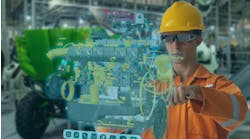“I wrote in my third grade journal that I wanted to be an aerospace engineer,” says Eric Becnel, vice
president and chief engineer of RadioBro Corporation. In his childhood, all signs pointed up into the sky. “Our parents are both computer-science majors and met at university, our father is a private pilot, and we all used to go to air shows.” With his twin brother Mark at his side, Eric’s wish came true. When they graduated, the two Masters of Science in Aerospace Engineering founded RadioBro Corporation.
The place to be for aeronautics-lovers
The brothers’ company is based in Huntsville, Alabama, a development hub for NASA, an engineering mecca in the US and the place to be to develop ideas, design, and manufacture aerospace systems. "It’s a very challenging market because our customers are very aware of the state-of-the-art," says Mark Becnel. The president of RadioBro affirms that, “They’re extremely passionate about telling you what they want and what they don’t like.”
RadioBro designs and produces aviation, orbital and industrial electronics systems, focusing on plug-and-play data-acquisition technology. Up in the air and in other harsh environments, that’s where the electronics systems from RadioBro are proving their USPs best. “We offer kitted solutions that collect data, connect machines, and distribute the data,” says Eric. “The devices take measurements, store them, and display them on a website in real-time. Temperature, pressure, stresses: These are just three examples of the measurements taken by our instruments. And these data can verify the engineering of anything.”
Under the name “Cyclone,” RadioBro brings the IoT into the expensive aircraft-test market, the two owners explain. Typical test preparation can take up to two months, but with Cyclone, testing has been reduced to weeks, resulting in faster time-to-market and significantly reducing testing costs for their customers.
Measurements in the air and on earth
While Cyclone for aerospace applications operates at up to 23,000 feet in altitude (so far), Cyclone for industrial applications works just as reliably on ground level. Here the system also might measure pressure, vibration and temperature on a machine or on an assembly line in manufacturing. “This is important for companies that want to upgrade their equipment to the IoT, which allows an operator to monitor all of the equipment’s parameters and its performance,” Eric says.
These industrial customers once only received updates based on a manual inspection. “Now with the easy to install Cyclone, the measurements are automated, and they are able to receive the data immediately.” If something goes wrong, operators onsite and remotely will find out much sooner than in the past.
Familiar with the twin concept
Being twins themselves, it might not be a coincidence that digital twins play a crucial role in the Becnel’s business. “The fact we have access to and are familiar with Siemens' CAD system Solid Edge was key in our original business plan,” Mark recalls. “This was a key enabling factor from day one.”
Using Solid Edge software has many advantages for RadioBro. “It is affordable and flexible, the intuitive user experience reduces the training time and enables the use of more powerful features, and the powerful features allow for rapid design-for-production used in supplier management,” Mark summarizes.
Cost of ownership
“Every small business has to be risk-averse in order to change the way business is done,” Mark claims. “A monthly subscription to a reasonably priced software helps. Even small companies like startups can afford software with the little bit of money they have. And they don’t have to put themselves at risk.”
“The licenses for Solid Edge were much more affordable than any of Siemens’ competitors,” Mark says. “Siemens also guarantees that we can migrate our files, and access more advanced versions of the software through subscription licensing as needed without having to make a capital investment.”
Design for production
The engineers develop all of their products using Solid Edge. The software comes in very handy: for example, if a supplier asks for a different tooling requirement, the change can be digitally modeled, interferences evaluated, and assembly simulations executed. The 3D models are very useful on our scale of tiny and highly integrated devices.
However, most of RadioBro’s suppliers and customers work with 2D drawings. “We can update the 2D drawings in less than 30 minutes,” Mark says. “And we can push all the updated drawings to our supply chain and get the project on its way. Firms like ours would usually work with a red-line modification, and the next time we’d do a major modification we’d update the drawings.” Now RadioBro can do it right away, in real time.
Whether it’s needed for integration with an aircraft or production of component in a factory, the actual time needed to install the RadioBro solution is critical, because the equipment must be switched off during installation. The advanced tool that RadioBro uses now saves the customers and suppliers time and money. “We learned this lesson on our first-generation product development and deployment,” Eric says.
After developing and selling the second-generation Cyclone system, RadioBro now spends far less time at their customers’ sites, and the product works much better in operation, and remains much longer in the field. “Today, our customers’ experience is much more streamlined and easy,” Eric says.
More to come with new functionalities
Mark and Eric wouldn’t be ambitious aerospace engineers if they didn’t have high expectations of the tools they work with. “We always want to see continuous improvement–that keeps us competitive and increases our opportunities,” Mark says with tongue in cheek. “A big thing for us is getting the customer’s approval. This process has also become digitized. We are just starting to use the new built-in data management. This is going to help us a lot, because it means that no one would have to leave the software as soon as the customer gives us their approval.”
The integration of Mentor Graphics into Solid Edge is also eagerly awaited by both company owners. “One of our new requirements is thermal analysis, so we’re very excited to start using the new FloEFD tool with Solid Edge,” Eric says. Mentor Graphics will also be used for integrated circuit design, because the engineers are constantly working with multiple circuit cards. “The ability to work in an integrated environment will help us work more efficiently and help us decrease our time-to-market even further.”
Solid edge for startups
RadioBro participates in the Solid Edge for Startups program that provides early-stage startups with free use of Solid Edge Premium software for a year. The companies also have access to Solid Edge training resources and guidance from an online community of product experts. If RadioBro’s revenue is strong enough after this year is over, they can easily maintain their software and scale it to their needs with a monthly subscription.
Solid Edge ST10 is already on RadioBro’s horizon. “It is changing the way products are designed entirely, and is making our quality system more efficient,” Mark says. “In my opinion, it’s still a too well-kept secret, if you consider the capability of it.”
We’ll see if the new generative design tool meets–or even exceeds–the twins’ expectations.
*This piece originally appeared in Siemens' The Magazine.


